In this video, you will find out:
- What is more important if you’re buying a property: the building or the land?
- How the Great Australian Dream has shrunk.
- Where to find the value of a building relative to the land.
- Why real estate agents say - it's location, location, location.
Video Outline:
The building or the land?
What’s more important when buying a property?
Is it the building or is it the land?
When you buy a property, you are buying one property which consists of two separate parts. The first part is the land. The second part is the building.
The land increases in value over time because land becomes scarce. As they say, they’re not making any more land.
The building decreases in value over time because it grows old, it needs renovation and repairs to bring it up to date. Some buildings fall so out of repair they are demolished and rebuilt. Other buildings are built on land that is so valuable that the building is demolished and developed into duplexes, townhouses, home units and so forth.
Key points:
- If you are looking at capital gain, look at the land.
- If you are looking at rental income, look at the building.
- If you are looking for income while you wait for capital gain, buy a property in a good location.
How the Great Australian Dream has shrunk
Let’s look at land.
Land has been increasing in value in Australia over the past 200 or more years.
When the colony of Sydney was established 200 years ago, land was plentiful and the Governor sold off acres of land, often enough for a suburb.
Take William Balmain who in 1801 purchased 550 acres of land in the suburb which is now called Balmain; the same with Archibald Mosman who purchased land in the suburb now called Mosman; and Captain John Piper – his land has become the most expensive real estate in Australia – Can you guess? - the suburb of Point Piper.
Let’s take an example of land which has increased in value in the Sydney Area in the last 200 years:
In 1813, Governor Macquarie granted 570 acres to Esther Julian. The land was a long way from the Sydney CBD. It was near Bankstown, which is 22 kms away.
Not much happened for the next 76 years, to disturb the kangaroos as they hopped around the trees on the land. Then in 1889 the demand for housing reached the land and it was subdivided into housing lots.
They were large lots, quarter acre blocks, which is about 1,000 square metres. Large enough for the Great Australian Dream – a house at the front, a large shed, a vegetable patch and right at the back, a chook house where the hens would lay eggs for breakfast.
The subdivision was large – 707 lots. In fact, it was large enough for a whole suburb. Today it is called Revesby.
This is the original plan:
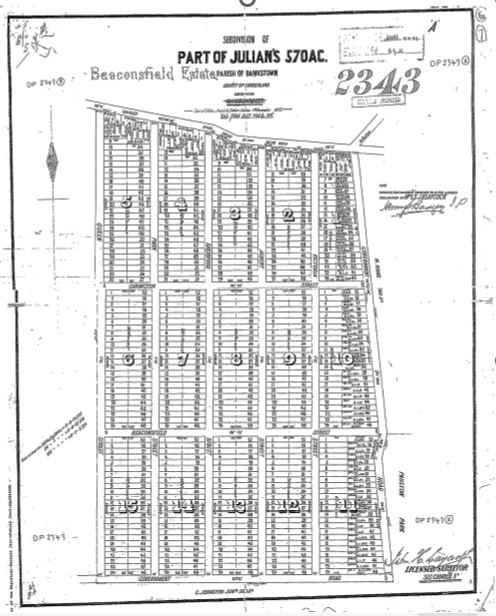
Over the years since 1889, more and more land was subdivided in the Sydney Metropolitan Area to meet the demand for housing.
By the 1950s, they were running out of land. The lot sizes had shrunk from 1,000 square metres to 500 square metres. The Great Australian Dream was now half size at 500 square metres.
And still there was not enough land.
So in 1961, the New South Wales Government came up an inspired solution. That was to subdivide the airspace above the land vertically, to create separate titles. Each level is called a stratum. Guess what they called it? Strata title because there are many levels.

Strata title is title where the owner owns the airspace above the land, and also has a share in the land on which the building stands.
Strata Title took a while to catch on because no-one was interested in buying airspace, but strata tile proved to be popular over the years. Today, there are over 80,000 strata title schemes in New South Wales. What’s more, the idea has spread around the world. It was a world first.
What is the Great Australian Dream for at least one-third of the people who live in Sydney live in home units?
It is a two-bedroom home unit of 85 square metres including balcony, plus garage. It has shrunk. It’s one tenth of what it used to be.
Key points:
- Quarter acre blocks in Julian’s subdivision at Revesby sell for $1.6 million today.
- Two-bedroom home units built on blocks in Julian’s subdivision sell for $500,000 today.
Where to find the value of a building relative to the land
Let’s now look at buildings.
Buildings don’t become scarce like land does – new buildings are being built all the time.
Houses are being demolished. Home units are being built.
When you are buying a property, you buy the land and the building. But you don’t get told how much you are paying for the land and how much you are paying for the building.
It’s very hard to find out this information when you are buying a house or a normal building unless you get a registered value to carry out a proper valuation.
But when you are buying a strata property, the information is readily available. The reason is that strata schemes are required by law to have the building valued at minimum of every 5 years for insurance purposes. The valuation is for building reinstatement fin the case where the building falls down because of storm and tempest or earthquake, or is damaged because of a fire.
The building insurance amount is available to purchasers when buying a home unit.
Once you know how much the strata building is insured for, you can work out the building value for an individual home unit or townhouse. For example, if the building value is $3,000,000 and there are 10 home units, you divide by 10 and come up with a $300,000 building value per home unit.
Why real estate agents say - it's location, location, location
Let’s look at four examples of home units each built 50 years ago in around 1970 in Sydney.
So that we are comparing like for like, let’s compare two-bedroom home units, with one bathroom and one car space, in home unit blocks of between 9 and 15 home units.
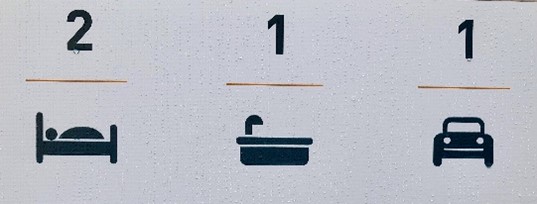
What you will notice is that the further away from the Sydney CBD, the less valuable the property is, and the less valuable the land is.
Conversely, as you get closer, the land content gets higher but the building value does not change a great deal.
We start with the cheapest which is the furthest from the Sydney CBD.
(1) At Dundas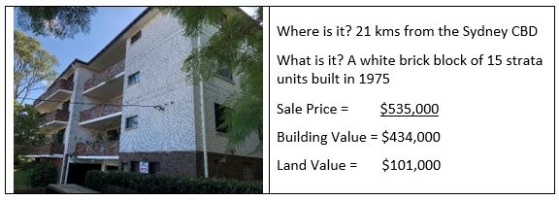
(2) At West Ryde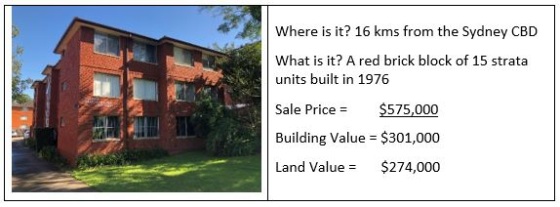
(3) At Ashfield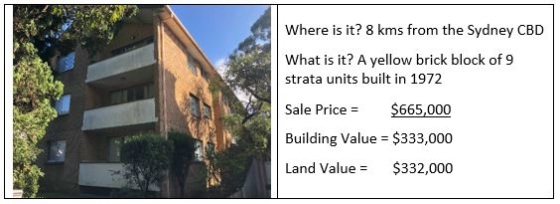
(4) At Wollstonecraft
You will notice that the building value does not vary much – it is ranges between $301,000 and $434,000.
But the land value steadily increases from $101,000 to $752,000, the closer you get to the Sydney CBD.
Where is the home unit with the highest price? At Wollstonecraft. In the best location.
That is why the money is in the land.
As the real estate agents say – location, location, location.
